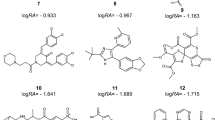Abstract
The integrin VLA-4 (α4β1) is involved in the migration of white blood cells to sites of inflammation, and is implicated in the pathology of a variety of diseases including asthma and multiple sclerosis. We report the structure-activity relationships of a series of VLA-4 antagonists that were based upon the integrin-binding sequence of the connecting segment peptide of fibronectin (Leu-Asp-Val), and of VCAM-1 (Ile-Asp-Ser), both natural ligands of VLA-4. We explore variation in the ligand derived peptide portion of these antagonists and also in the novel N-terminal cap, which have discovered through chemical optimization, and which confers high affinity and selectivity. Using the X-ray derived conformation of the Ile-Asp-Ser region of VCAM-1, we rationalize the structure-activity relationships of these antagonists using 3D QSAR (COMFA). The COMFA model was found to be highly predictive with a cross-validated R2 CVof 0.7 and a PRESS of 0.49. The robustness of the model was confirmed by testing the influence of various parameters, including grid size, column filtering, as well as the role of orientation of the aligned molecules. Our results suggest that the VCAM-1 structure is useful in generating highly predictive models of our VLA-4 antagonists. The COMFA model coupled with the knowledge that the peptide amides are tolerant to methylation should prove useful in future peptidomimetic design studies.
Similar content being viewed by others
References
Leger, O.J., et al., Hum. Antibodies, 8(1997) 3–16.
Molossi, S., et al., J. Clin. Invest., 95(1995) 2601–2610.
Elices, M.J., Ciba Found. Symp., 189(1995) 79–85.
Abraham, W.M., et al., J. Clin. Invest, 93(1994) 776–787.
Sagara, H., et al., Int. Arch. Allergy Immunol., 112(1997) 287-294.
Podolsky, D.K., et al., J. Clin. Invest., 92(1993) 372–380.
Burkly, L.C., A. Jakubowski, and M. Hattori. Diabetes, 43(1994) 529–534.
Yang, X.D., et al., Proc. Natl. Acad. Sci., 90(1993) 10494–10498.
Chabot, S., G. Williams, and V.W. Yong, J. Clin. Invest, 100(1997) 604–612.
Seiffge, J. Rheumatol., 23(1997) 287–294.
Komoriya, A., et al., J. Biol. Chem., 266(1991) 15075–15079.
Humphries, M.J., et al., 189(1995) 177–191.
Makarem, R., et al., J. Biol. Chem., 269(1994) 4005–4011.
Jones, E.Y., et al., Nature, 373(1995) 539–544.
Wang, J.H., et al., Proc. Natl. Acad. Sci. (USA), 92(1995) 5714–5718.
Ling, L., et al., Biochemistry, 37(1998) 8743–8753.
Kubinyi, H., QSAR and 3D QSAR in drug design. Part 1: methodology. Kluwer, Dordrecht, 2(1997) 457–466.
Cramer, R.D., D.E. Patterson, and J.D. Bunce, J. Am. Chem. Soc., 110(1988) 5959–5967.
Lin, K.C., et al., J. Med. Chem., 42(1999) 920–934.
Cho, S.J. and A. Tropsha, J. Med. Chem., 38(1995) 1060–1066.
Lobb, R.R., et al., Cell Adhes. Commun., 3(1995) 385–397.
Cambridge Crystallographic Database: 12 Union Road, Cambridge CB2 1EZ, UK.
MOPAC, Quantum Chemistry Program Exchange: Creative Arts Building 181, Indiana University, Bloomington, Indiana 47405, USA.
Agarwal, A., et al., J. Med. Chem., 36(1993) 4006–4014.
Renz, M.E., et al., J. Cell. Biol., 125(1994) 1395–1406.
Ku, J. Am. Chem. Soc., 2(1993) 897.




